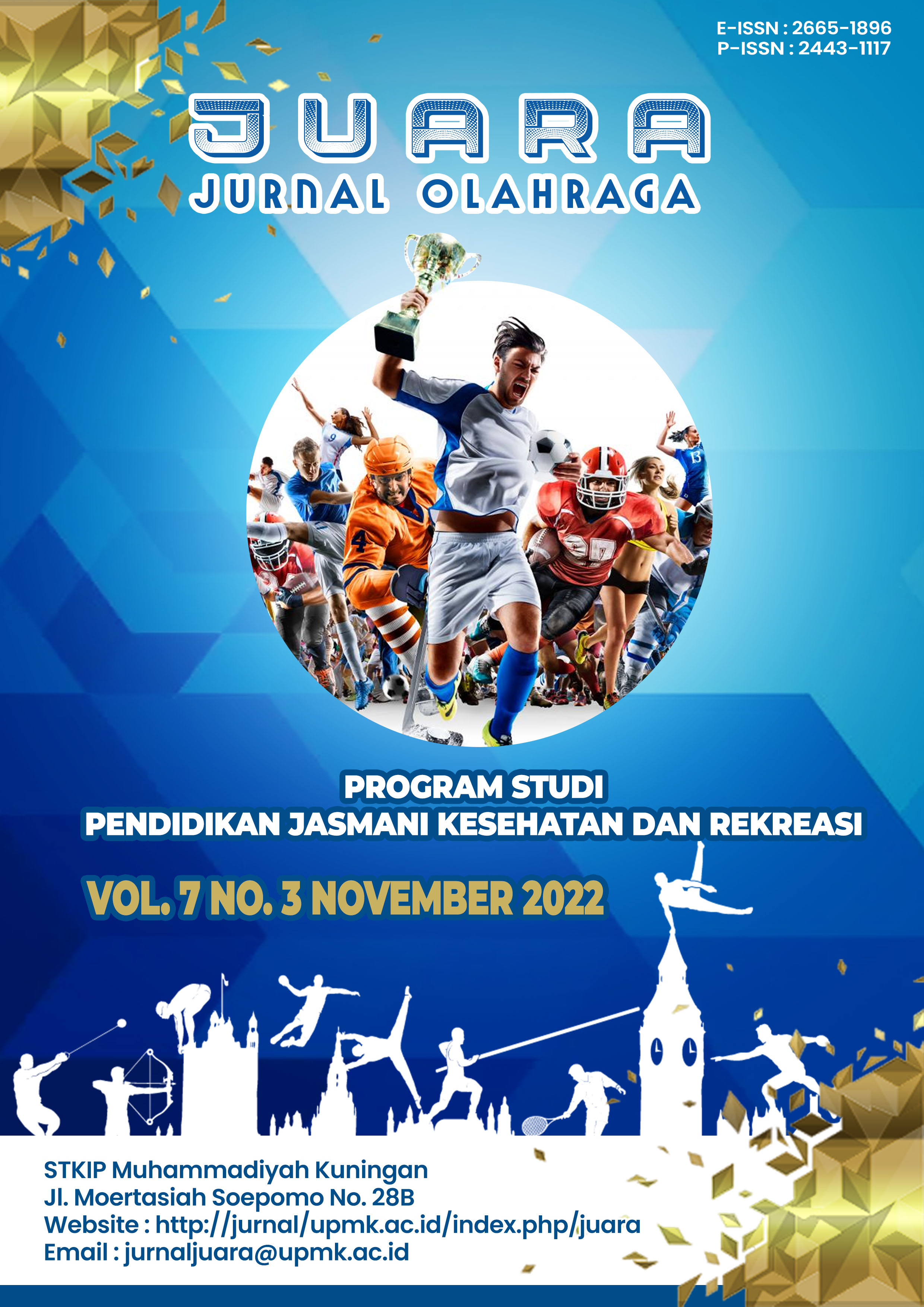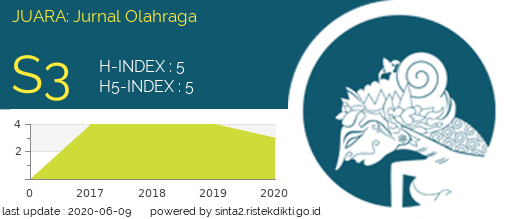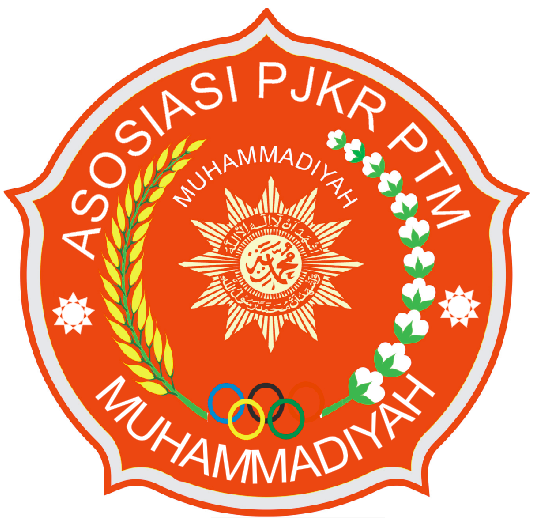The Effect of Training Methods and Hand Eye Coordination on the Accuracy of Backhand Drive in Table Tennis Athletes
Abstract
This study aimed to analyse the effect of the two-way and random feed drill training method on the accuracy of the backhand drive of PTM barokah Jaya Purwokerto, table tennis athletes. This study used an experimental method with a 2x2 factorial design and data analysis techniques using Analysis Of Variance (ANOVA) at the significance level (ñ: 0.05). The population in this study were PTM Barokah Jaya Purwokerto table tennis athletes, totalling 28 people. The results of this study: There are differences in the effect of the random feed and two-way drill training methods on the backhand drive. Two-way bait drill exercise is better than unexpected bait drill on the accuracy of backhand drive PTM Barokah Jaya Purwokerto table tennis athletes. There are differences in the effect of high and low hand-eye coordination on the accuracy of the backhand drive. Athletes with high hand-eye coordination are better than athletes with low hand-eye coordination against PTM Barokah Jaya Purwokerto table tennis athletes. There was no interaction between training methods and hand-eye coordination on the accuracy of backhand drives in PTM Barokah Jaya Purwokerto athletes. The conclusions of this study are 1). The two-way feed drill training method is better than the random feed drill. 2). Players with high hand-eye coordination are better than those with low hand-eye coordination. 3). there was no interaction between training methods and eye-hand coordination on the accuracy of the backhand drive of PTM Barokah Jaya Purwokerto table tennis athletes.
Downloads
References
Alaswati, S. (2016). Journal of Physical Education and Sports. 5(2), 111ââ¬â119.
Azwar, S. (2016). Norma Penilaian Forehand drive dan Backhand drive Tenis Meja. Pustaka Pelajar Offset.
BaÃâkosz, Z., & Winiarski, S. (2020). Kinematic parameters of topspin forehand in table tennis and their inter-and intra-individual variability. Journal of Sports Science and Medicine, 19(1), 138ââ¬â148.
Carrasco, L., Pradas, F., FlorÃÂa, P., MartÃÂnez, A., Herrero, R., Antonio, J., & Jurado, G. (2010). Grip Strength in Young Top-level Table Tennis Players. International Journal of Table Tennis Sciences, 6(6), 64ââ¬â67.
Edward, W. . (2011). Motor learning and control: from theory to practice. Sacra-mento: California State University. California State University.
Florendo, F and Bercades, D. . (2007). The effectiveness of shadow practice in learning the standard forehand drive. April 2011, 105. http://www.ittf.com/ittf_science/SSCenter/Int_Journal6/table_tennis.pdf
Ghoneim, Y. K. M. S., & Salem, A. S. (2010). Analytical study for some offensive skills for advanced level junior players in the ITTF pro-tour Egypt 2008. International Journal of Table Tennis Sciences, 6(6), 83ââ¬â93.
Haryanto, J., & Amra, F. (2020). The relationship of concentration and eye-hand coordination with an accuracy of backhand backspin serve in table tennis. International Journal of Technology, Innovation and Humanities, 1(1), 51ââ¬â56. https://doi.org/10.29210/881701
Hastjarjo, T. D. (2019). Rancangan Eksperimen-Kuasi. Buletin Psikologi, 27(2), 187. https://doi.org/10.22146/buletinpsikologi.38619
Langga, Z. A., & Supriyadi. (2016). Pengaruh Model Latihan Menggunakan Metode Praktik Distribusi Terhadap Keterampilan Dribble Anggota Ekstrakurikuler Bolabasket SMPN 18 Malang. Jurnal Kepelatihan Olahraga, 1(1), 90ââ¬â104.
Larry Hodges. (2007). Tenis Meja Tingkat Pemula. Raja Gravindo Persada.
Mahendra, I. R., Sugiyarto, S., & Kiyatno, K. (2014). FAKTOR KONDISI FISIK DOMINAN PENENTU PRESTASI BERMAIN TENIS MEJA (Analisis Faktor Fleksibilitas Pergelangan Tangan, Fleksibilitas Pinggul, Waktu Reaksi, Koordinasi Mata Tangan, Kelincahan , dan Power Otot Lengan Pada Mahasiswa Pembinaan Prestasi Tenis Mej. Indonesian Journal of Sports Science, 1(1), 1ââ¬â13.
Moso, A. A. (2013). Psychological and Motor-coordination Factors in Children Tennis Players. Procedia - Social and Behavioral Sciences, 78(February), pp. 220ââ¬â224. https://doi.org/10.1016/j.sbspro.2013.04.283
Palmizal, A. (2011). Pengaruh Metode Latihan Global terhadap Akurasi Ground Stroke Forehand dalam Permainan Tenis. Media Ilmu Keolahragaan Indonesia, 1(2). https://doi.org/10.15294/miki.v1i2.2029
Pradas, F., Ara, I., Toro, V., & Courel-Ibáñez, J. (2021). Benefits of regular table tennis practice in body composition and physical fitness compared to physically active children aged 10ââ¬â11 years. International Journal of Environmental Research and Public Health, 18(6), 1ââ¬â11. https://doi.org/10.3390/ijerph18062854
Pratama, S. A., & Budiman, B. (2017). Hubungan Koordinasi Mata Tangan, Kekuatan Lengan dan Motivasi Berprestasi dengan Ketepatan Forehand dalam Tenis Meja. Jurnal Penelitian Dan Pengkajian Ilmu Pendidikan: E-Saintika, 1(1), 11. https://doi.org/10.36312/e-saintika.v1i1.2
Pritama, M. A. N., Sugiharto, & Rahayu, S. (2014). Pengaruh Metode Latihan Smash dan Koordinasi Mata Tangan dengan Menggunakan Umpan Langsung dan Tak Langsung Umpan pada Bulutangkis. Journal of Physical Education and Sports, 3(1), 46ââ¬â50.
Pujianto, A. (2015). Profil Kondisi Fisik Dan Keterampilan Teknik Dasar Atlet Tenis Meja Usia Dini Di Kota Semarang. Journal of Physical Education Health and Sport, 2(1), 38ââ¬â42. https://doi.org/10.15294/jpehs.v2i1.3941
Rachman, I., Sulaiman, & Rumini. (2017). Pengembangan Alat Pelontar Bola Tenis Meja (Robodrill IR-2016) Untuk Latihan Drill Teknik Pukulan Drive Dan Spin. Journal of Physical Education and Sports, 6(1), 50ââ¬â56.
Rahyubi, H. (2012). Teori-teori belajar dan aplikasi pembelajaran motorik (Cet. 1). Referens.
Ramadan, Gilang & Juniarti, Y. (2020). Metode penelitian : pendekatan kuantitatif, kualitatif dan R & D. CV Sadari Press.
Sajoto Mochamad. (1988). Pembinaan Kondisi Fisik Dalam Olahraga (Depdikbud (ed.)). Dirjen Dikti.
Salim, A. (2008). Buku Pintar Tenis Meja. Penerbit Nuansa.
Samsudin. (2017). Pengaruh Latihan Kelincahan Terhadap Keterampilan Menggiring Bola Dalam Permainan Sepak Bola. Jurnal Pendidikan Olahraga, 7(1), 1ââ¬â7.
Santosa, T. (2016). Pukulan forehand topspin masing- masing atlet. Kata Kunci: Pengembangan, Return Board , Top Spin , Tenis Meja 30. Jurnal Pedagogik Keolahragaan, 2, 30ââ¬â48. https://doi.org/10.22245/jpor.v2i2.4513
Sports, A. J., June, M., Asar, S., Ezabadi, R. R., Baghini, A. S., & Maleksabet, N. (2022). The Relationship Between Reaction Time, Eye-Hand Coordination with Visual Field in Elite Tennis Tennis Players. 13(2). https://doi.org/10.5812/asjsm-115787.Research
Subagja, D. S., Kusmaedi, N., & Komarudin, K. (2019). The Effect of Learning Media and Coordination To Forehand Top Spin Accuration on Table Tennis. JUARA : Jurnal Olahraga, 4(2), 220. https://doi.org/10.33222/juara.v4i2.619
Sudrajat, A., Nasuka, & Awang Irawan, F. (2019). Development of ANS PONG as a Tool for Block Training and Smash in Table Tennis Games. Journal of Physical Education and Sports, 8(1), 19ââ¬â25. https://journal.unnes.ac.id/sju/index.php/jpes/article/view/26164
Sukadiyanto. (2002). Pengantar Teori dan Metodologi Melatih Fisik. PKO FIK UNY.
Tomoliyus. (2014). Pengembangan instrumen kemampuan ketepatan fore hand, backhand drive dalam permainan tenis meja. 1ââ¬â14. http://staffnew.uny.ac.id/upload/131121717/penelitian/12.+Pengembangan+instrumen+Ketetapan+Forehand+dan+backhand+Drive+tenis+mejaNew+Microsoft+Office+Word+Document+_2_.pdf
Valdes-Badilla, P., & Perez-Gutierrez, M. (2018). Physical Conditioning for Combat Sports: Book review. Ido Movement for Culture, 18(1), 45ââ¬â48. https://doi.org/10.14589/ido.18.1.7
Widy Astuty , Setya Rahayu, S. (2015). Pengaruh Metode Pembelajaran Dan Koordinasi Terhadap Hasil Belajar Bolavoli Siswa Smp 2 Mayong Jepara Tahun 2011/2012. Journal of Physical Education and Sports, 4(1, ISSN 2252-6412), 79ââ¬â86.
Copyright (c) 2022 A Fani Kamalussadad, Harry Pramono, Endang Sri Hanani

This work is licensed under a Creative Commons Attribution-ShareAlike 4.0 International License.












